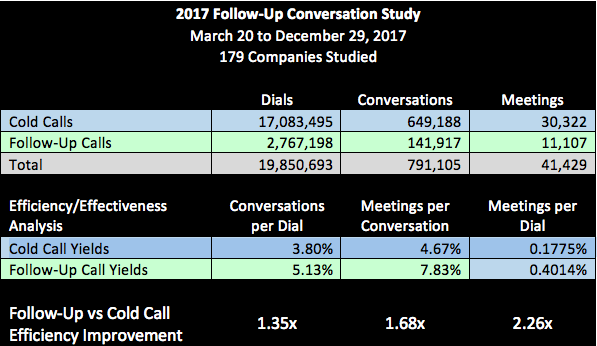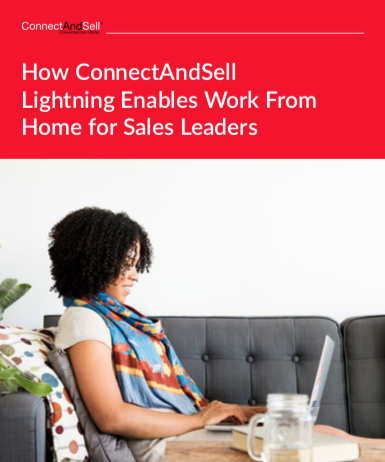
Relative Efficiency and Effectiveness of Cold vs. Follow-Up Calls
Overview:
In December 2017, ConnectAndSell conducted a comprehensive retrospective study on follow-up B2B telephone calling, comparing the efficiency and effectiveness of two basic calling scenarios:
- Cold calling — having initial conversations with prospects chosen for a combination of company characteristics and job titles.
- Follow-up calling — having second, or beyond, conversations with prospects who had initially been cold called.
Hypothesis:
Anecdotal evidence and analysis of calling outcomes had shown that calling effectiveness, measured as yield of the end product of unscheduled conversations — scheduled meetings — increased substantially for follow-up conversations, defined as conversations with prospects who had already participated in at least one previous conversation with a member of the calling team. There was also evidence of systematic improvements in calling efficiency for follow-up conversations, as measured in the yield of conversations from dialing activity.
The hypothesis of this study was that both calling efficiency and appointment-setting effectiveness are independently superior to cold calling.
Method:
The study covered the period from March 20 through December 29, 2017, using production calling data from 179 companies using the automatic follow-up management feature of ConnectAndSell’s conversations-on-demand service. Calling was done by both appointment-setting specialists, referred to as sales development representatives (SDRS) and full-cycle senior sales representatives, referred to as account executives (AEs). Throughout this paper, those study participants will simply be called “sales reps” or “reps.” First conversations will be called “cold conversations”; second, third, and subsequent conversations will be called “follow-up conversations.”
The study examined the results of 19,850,693 dial attempts that resulted in 791,105 conversations and generated a total of 41,429 scheduled meetings. The results of each conversation were recorded by the ConnectAndSell system based on a forced drop-down list selection made by the sales rep at the conclusion of each conversation. The study data did not include either the attendance statistics for those scheduled meetings nor any results from those meetings that were held.
Results:
The table above shows the results for each of the campaign types.
Discussion of Results:
Follow-up calls significantly outperformed cold calls in overall effectiveness, delivering 2.26 times as many meetings per dial attempt.
This was due to two independent factors: dialing efficiency and conversation effectiveness. Assuming the constant labor required to make and navigate both kinds of dial attempts, dialing efficiency depends linearly on the average number of dial attempts required to have one conversation. Similarly, conversation effectiveness depends on the average number of conversations required to schedule one meeting.
Cold call dial attempts comprised 86.06% of all dial attempts studied, produced 82.06% of all conversations, and generated 73.19% of all meetings.
Follow-up call attempts comprised 13.94% of all dial attempts, produced 17.94% of all conversations, and generated 26.81% of all meetings.
Looked at from a level-of-effort perspective, it took 26.32 cold call dials to connect one conversation, whereas it took only 19.50 follow-up call dials to connect one conversation. This represents a 25.9% reduction of dialing effort to achieve the same number of conversations by calling follow-ups, or prospects with whom the rep has already had at least one conversation, compared to cold prospects that have not yet had a first conversation.
From a yield perspective, cold call dial-attempts resulted in a conversation 3.80% of the time, whereas follow-up dial-attempts resulted in a conversation 5.13% of the time — a 35% (1.35 times) improvement in dial yield.
The root cause of this improvement in dialing efficiency was due to a straightforward selection effect: the follow-up set of prospects consisted entirely of individuals for whom the caller had validated phone contact data and those who had demonstrated by past behavior that they answer phone calls, at least on occasion. That is, these follow-up calling lists effectively excluded all bad contact data and further excluded those prospects who don’t ever answer their phone.
A second, independent effect of calling on follow-up lists is improvement in conversation effectiveness. Again, from a level-of-effort perspective, it took 21.41 cold conversations to produce one scheduled meeting, whereas it took only 12.78 follow-up conversations to produce one scheduled meeting. This represents a 40.31% reduction of conversation effort to achieve the same number of meetings by calling follow-up versus cold prospects.
From a yield perspective, cold call conversations resulted in a scheduled meeting 4.67% of the time, whereas follow-up conversations yielded a scheduled meeting 7.83% of the time — a 68% (1.68 times) improvement in dial yield.
The root cause of this improvement in conversation effectiveness is probably due to more complex factors than the improvement in dialing efficiency. Two factors that likely influence the improvement for follow-up conversations are:
- Conversational context is easier to establish based on the previous conversation.
- There is some level of familiarity that has been established by the previous conversation.
Because these two effects — dialing efficiency and conversation effectiveness — are independent, the overall improvement in output per dial attempt is 126% (2.26 times)..
Conclusion:
Calling follow-up prospects, defined as those prospects with whom one has had at least one conversation, is 2.26 times as productive per dial compared with calling cold prospects to have first conversations.
One way of looking at this effect is to calculate how many additional scheduled meetings this study group of 179 companies would produced over the same period using the same amount of effort had their dial attempts been spread equally over cold and follow-up attempts. In this scenario, 9,925,347 follow-up dials, by themselves, would have resulted in a total of 39,839 meetings, which is 96% as many meetings as the 41,429 meetings that were produced by the mix of dials actually executed. These meetings from follow-up dials would have been in addition to the 17,866 meetings produced from cold dial attempts to yield a total of 57,705 meetings — an increase of 16,276 meetings, or 39%, compared to the results measured from the cold-to-follow-up mix found across the study data.
In other words, by simply shifting the mix of cold calls to follow-up calls from 86/14 to 50/50 — a zero-cost change that can be made by a simple choice of which lists to make dials from — companies can achieve the equivalent output of hiring, onboarding, training, and ramping almost four additional reps per every 10 reps currently on their team.
This study shows that to get these remarkable results doesn’t require any investment in new sales technologies, training, a bigger team, coaches, or sales process improvement. They are simply the result of systematically creating and calling follow-up opportunities, which can be accomplished by disciplined management of an optimized mix of calling lists that include at least 50% follow-up calls.
To summarize, the return on investment of increasing the percentage of follow-up calls in the overall calling mix is effectively infinite. A zero-dollar investment to optimize calling-mix yields immediate, significant, and measurable returns in the form of more scheduled meetings with arguably better-qualified prospects who have had more opportunities to consider taking a meeting before doing so.
These results illuminate a simple path to immediate sales productivity improvement and should be considered carefully by every B2B sales manager.

